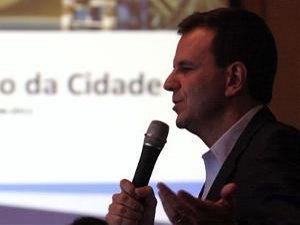 This past Tuesday, the Rio municipal government established, by the Mayor’s decree, the Council for the City’s Legacy, a group of people who will act as consultants in the matter of how to ensure a legacy is left for the city of Rio de Janeiro, beyond the World Cup and the Olympics. The Council will include representatives of public administration entities such as the Municipal Housing and Development Offices, and the Office of the State Chief of Staff, representatives of the Organizing Committees for both the World Cup 2014 and the Olympics 2016, up to 5 local entrepreneurs and representatives of the Rio de Janeiro Commercial Association, the Brazilian Institute of Architects, Association of Real Estate Market Managers and the NGO Rio Como Vamos. Those should be considerable indicators of what sort of legacy is envisioned by the City.
This past Tuesday, the Rio municipal government established, by the Mayor’s decree, the Council for the City’s Legacy, a group of people who will act as consultants in the matter of how to ensure a legacy is left for the city of Rio de Janeiro, beyond the World Cup and the Olympics. The Council will include representatives of public administration entities such as the Municipal Housing and Development Offices, and the Office of the State Chief of Staff, representatives of the Organizing Committees for both the World Cup 2014 and the Olympics 2016, up to 5 local entrepreneurs and representatives of the Rio de Janeiro Commercial Association, the Brazilian Institute of Architects, Association of Real Estate Market Managers and the NGO Rio Como Vamos. Those should be considerable indicators of what sort of legacy is envisioned by the City.
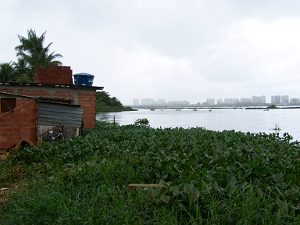 Two days later, a court ruling was circulated through REME (a nationwide network that keeps track of developments related to the sporting mega events Brazil is set to host) authorizing the removal of residents and the demolition of homes in Vila Autódromo that sit within 25m of the Lagoa de Jacarepaguá, in addition to ruling them liable for environmental damages, as well as landscaping, aesthetic and touristic damages caused by the disorderly settlement of the area known as Vila Autódromo. The ruling goes on to declare that residents are not to be held accountable for the costs incurred by the environmental damages, or for those related to the demolition of their own homes, as this is a low-income population and the carrying out of this sentence would be considered unfeasible or would result in long delays.
Two days later, a court ruling was circulated through REME (a nationwide network that keeps track of developments related to the sporting mega events Brazil is set to host) authorizing the removal of residents and the demolition of homes in Vila Autódromo that sit within 25m of the Lagoa de Jacarepaguá, in addition to ruling them liable for environmental damages, as well as landscaping, aesthetic and touristic damages caused by the disorderly settlement of the area known as Vila Autódromo. The ruling goes on to declare that residents are not to be held accountable for the costs incurred by the environmental damages, or for those related to the demolition of their own homes, as this is a low-income population and the carrying out of this sentence would be considered unfeasible or would result in long delays.
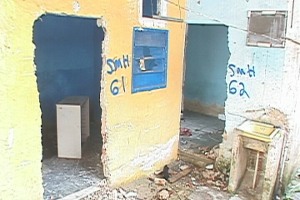 Following this stage, the course of action the government has typically employed includes sending staffers to the community to list residents and homes, mark buildings for demolition with the encryption SMH, for Secretaria Municipal de Habitação (the Municipal Housing Secretariat) followed by a number which identifies the individual building. Buildings deemed to be businesses are marked as such, thenceforth denied any compensation for its loss to those who depend on it for income, a practice that Rio’s public defenders assert is completely illegal, however widely employed by our officials. Contrary to the pleas of many, a community is never treated as a collective entity. Residents are dealt with one family at a time, stimulating demobilization, fear and uncertainty. As each resident accepts the government’s offers, a pile of rubble is left behind, or otherwise a home partially demolished, accumulating rainwater and attracting pests, deteriorating the lifestyle of every other resident, making the prospect of submitting to pressure and allowing oneself and one’s family to be moved to distant Cosmos and Campo Grande seem more and more like the only choice.
Following this stage, the course of action the government has typically employed includes sending staffers to the community to list residents and homes, mark buildings for demolition with the encryption SMH, for Secretaria Municipal de Habitação (the Municipal Housing Secretariat) followed by a number which identifies the individual building. Buildings deemed to be businesses are marked as such, thenceforth denied any compensation for its loss to those who depend on it for income, a practice that Rio’s public defenders assert is completely illegal, however widely employed by our officials. Contrary to the pleas of many, a community is never treated as a collective entity. Residents are dealt with one family at a time, stimulating demobilization, fear and uncertainty. As each resident accepts the government’s offers, a pile of rubble is left behind, or otherwise a home partially demolished, accumulating rainwater and attracting pests, deteriorating the lifestyle of every other resident, making the prospect of submitting to pressure and allowing oneself and one’s family to be moved to distant Cosmos and Campo Grande seem more and more like the only choice.
When City Hall entered the community of Vila Harmonia late last year, one staffer was reported to drop an eviction notice at someone’s doorstep and simply sprint off the community before anyone realized what their visit was about. During negotiations, staffers have allegedly pressured residents into unacceptable settlements by threatening to simply come and level the house when they are not in, as reported in Vila Recreio II. Knowing there is no legal paper ensuring ownership of their home, favela residents are too vulnerable to this sort of pressure, having truly no means of retribution should they ever come home to a torn up house. Some residents are too afraid to even leave their home unoccupied, and are thus unable to further their personal goals, their energy solely devoted to the defense of their home.
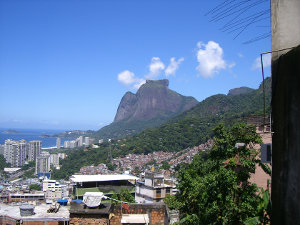 It must be noted that Rio de Janeiro’s law (known as the Lei Orgânica do Município, Article 429, paragraph VI) states plainly that there is to be no removal of squatter communities unless the occupied land presents a physical risk to the citizens that live on it. On several instances the government has used or tried to use the risk of landslides to justify the removal of a poor community, as is the case for the removal of homes in Laboriaux, at the top of Rocinha, an objective that the government still tries to reach.
It must be noted that Rio de Janeiro’s law (known as the Lei Orgânica do Município, Article 429, paragraph VI) states plainly that there is to be no removal of squatter communities unless the occupied land presents a physical risk to the citizens that live on it. On several instances the government has used or tried to use the risk of landslides to justify the removal of a poor community, as is the case for the removal of homes in Laboriaux, at the top of Rocinha, an objective that the government still tries to reach.
In opposition, it is claimed that the areas are not in fact at risk and that other areas truly at high risk, even inside Rocinha, where residents are pleading to be moved elsewhere, are neglected. The government names the specialist who examines the site to determine whether or not there is a risk. Certainly, the credentials of such specialists and the veracity of their findings is often called into question. The Lei Orgânica do Município is also being violated once the government relocates residents to apartments in Cosmos or Campo Grande. As item c) under the sixth paragraph of Article 429 states, if relocation is necessary, it can only be to a nearby site, so as to preserve the interpersonal and professional relationships that permeate the lives of locals. This item has been plainly ignored by Rio de Janeiro’s municipal government in recent times.
According to the Lei Orgânica, once a family negotiates with the government, there are three ways in which they can be resettled: relocation to a social housing complex, cash compensation, or assisted purchase. The social housing developments used are part of the federal Minha Casa Minha Vida (My House My Life – MCMV) program, which is designed to help lower income populations across Brazil become home owners. Those subsidized homes that municipal governments have access to could be used to house, for example, the thousands displaced by the tragedies of the Região Serrana earlier this year, but Rio de Janeiro instead employs it to relocate people with secure, standing homes, in order to expand roads, parking lots and build “buffer zones” (such as is the case in Vila Autódromo) for the Olympic Games and the World Cup. Still, this option does not come free: relocated residents are charged a “symbolic” fee of 50 reais a month for 10 years to purchase a home inferior in quality to the one they have worked years to build. Indeed they are not even relocated but rather forced into debt. Cash compensation has never been anywhere near a large enough sum to buy housing in a nearby area, as the law would require it. The third option, assisted purchase, is hardly ever employed despite being the clear preference of community residents. It requires the relocated family to seek a new home on its own and then go back to the government which will evaluate and buy it in the family’s name.
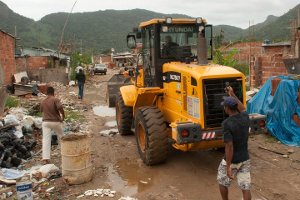 The question of how this can all happen is hard to answer. In today’s legal ruling threatening Vila Autódromo, a word search for Olympics or Olympic Games will turn up nothing, even though Vila Autódromo’s removal is widely known to be attributable to the construction of Olympic Games structures. In fact, the government’s own promotion videos for the Olympics show the area today occupied by Vila Autódromo as part of Olympic venues. Earlier, in 2010, it was said that Vila Autódromo’s land would be used for the Media Center. Later, it would have to be removed because of a mandatory security perimeter around Olympic Games structures. Today, it is to be removed because of environmental damages completely unrelated with last year’s Olympic plans, and residents are held responsible. We are led to believe by the latest ruling that this must all be just a coincidence.
The question of how this can all happen is hard to answer. In today’s legal ruling threatening Vila Autódromo, a word search for Olympics or Olympic Games will turn up nothing, even though Vila Autódromo’s removal is widely known to be attributable to the construction of Olympic Games structures. In fact, the government’s own promotion videos for the Olympics show the area today occupied by Vila Autódromo as part of Olympic venues. Earlier, in 2010, it was said that Vila Autódromo’s land would be used for the Media Center. Later, it would have to be removed because of a mandatory security perimeter around Olympic Games structures. Today, it is to be removed because of environmental damages completely unrelated with last year’s Olympic plans, and residents are held responsible. We are led to believe by the latest ruling that this must all be just a coincidence.
